Welcome to the week. Given that this is a holiday week and I have family staying at our house through Friday, things will be a bit quieter around here for the next few days. I do have a special Bike Happy Hour planned for Wednesday night though, so if you are in town we’d love to have you join us for a few special guests and a prize raffle. More details coming in a separate post later today.
For now, let’s get into the roundup…
WWTD: What Would Trump Do? Lots of folks are wondering how the new Trump Administration will impact transportation policy, including recently awarded federal grants. (Harvard Crimson)
Swiss say no to freeway expansions: Inspiring news from Switzerland where 53% of voters rejected a $5.6 billion government plan to expand highways after a strong campaign by the Green Party. (SwissInfo.ch)
Anti bike lane argument: As I’ve been trying to amplify here through coverage of political candidates from east Portland, local bike advocates would be very wise to take seriously critiques that say trade-offs for bike lanes aren’t worth it if there aren’t a lot of people using new infrastructure. (Washington Post Opinion)
Helmet history: An interesting look the innovative materials science on display inside helmets throughout history. (The Conversation)
Trump’s transpo pick: Major whiplash going from current Transportation Secretary Pete Buttigieg to outsider and Fox TV personality Sean Duffy, who many top transportation advocacy organization leaders say is a very “troubling” choice. (Streetsblog USA)
Trans america trail: The Great American Rail Trail is the name of what supporters hope will someday be a 3,500 carfree path from one coast to the other. (NY Times)
Bike shop burglary: A bike shop on Lower East Burnside suffered a bad break-in and has been buoyed by community support after being featured on several local TV stations. (KATU)
Unsanctioned signage: Activists in Boulder are so fed up with reckless, selfish, dangerous drivers they fashioned high-quality fake road signs to send them a message. (Colorado Public Radio)
Bike lanes are good, actually: Leaked documents that show removing bike lanes in Toronto would actually make congestion more severe — not less as divisive Ontario Premier Doug Ford has claimed — have added an interesting wrinkle to a heated debate. (The Guardian)
Wasteful decision: In what appears to be a ridiculous decision, Scottish port authorities turned back a shipment from a do-gooder who had prepped 500 bikes for a charity in war-torn Sudan on account of them being “waste” because they needed minor repairs. (BBC)
Thanks to everyone who sent in links this week. The Monday Roundup is a community effort, so please feel free to send us any great stories you come across.


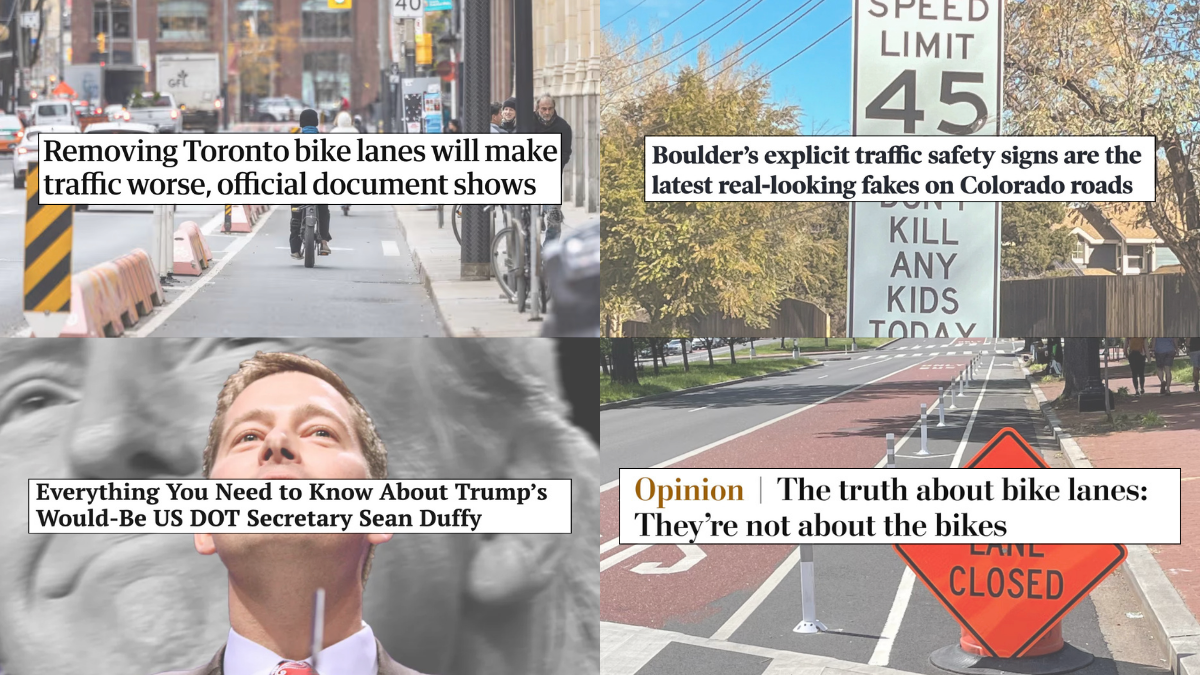
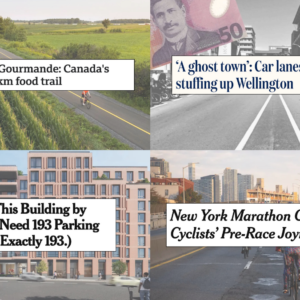
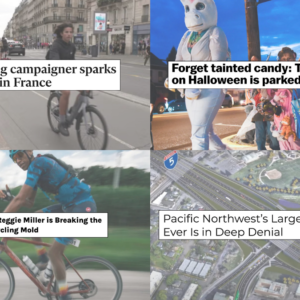
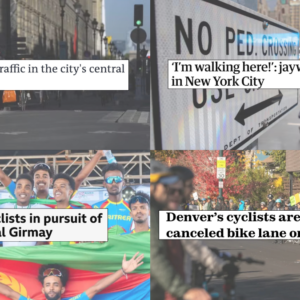
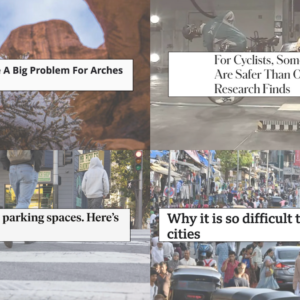
Thanks for reading.
BikePortland has served this community with independent community journalism since 2005. We rely on subscriptions from readers like you to survive. Your financial support is vital in keeping this valuable resource alive and well.
Please subscribe today to strengthen and expand our work.
Switzerland is decidedly not my favorite country, but good on them.
The commuting landscape changed permanently four and a half years ago, yet traffic in most cities is worse than ever, as though demand rebounded to need the supply. Just don’t say it was induced!
It wasn’t induced, or at least there’s no evidence it was using the definition of the term as I understand it.
Tell me if you disagree with any of these statements:
1) There are fewer daily trips to downtown. 2) There may be more trips to other locations (some employers moved out of downtown, and even WFH folks still want to get lunch sometimes, and they’re not going downtown to do it). 3) Buses only work well for select trips, most of which involving getting downtown. 4) Transit has taken a big hit in terms of perceived safety and cleanliness, deterring riders who have a choice. 5) Probably as a result of the above factors, more people are driving than pre-pandemic. 6) Because trips are more dispersed, congestion is lower, making driving seem easier than before.
Does that mean demand was “induced”? (And if so, by whom?) Overall, travel demand has, if anything, fallen. I think it is more accurate to say that the way we’re using our transportation system has changed.
If you are suggesting, or thinking, that when people say “induced demand” they mean people are driving because there is a road there, that explains some of your misconceptions about induced demand. People, as always, drive because it’s a way to get somewhere. If there is more road space, and we cater every single bit of our infrastructure to driving, then driving is also the fastest way. And so, people drive more until they have filled the space. Each individual choice has some excuse (“I was just getting lunch”, “the bus exposes me to my fellow person”, etc), but the fact that driving is made to be the fastest / easiest option until the roads are jammed full is what induced demand is.
It is? In this case, if travel patterns have changed, and driving works better for the locations people are now traveling to, we’re seeing “induced demand”?
That’s a new definition. I thought it was a more useful term when it meant something specific.
If we take away roadway capacity through road dieting, is that “deduced demand”?
Agree
Agree, but “may” is doing a lot of heavy lifting.
Disagree, though this is broadly historically true in Portland (and many US cities).
Unsure, since I don’t have a pre-Covid baseline. I have had a rounding error of bad experiences on the bus in Portland (most recently: a visibly unwell man who was talking very loudly to himself. I didn’t perceive him to be dangerous, other passengers seemed to ignore him)
I thought that driving had fully rebounded/exceeded pre-Covid as well, but if you look at traffic data from ODOT, you’ll find generally lower AADT on major state controleld routes in the Portland area. Traffic is down 4.3% on I-5, down 4.9% on I-84, down 4.3% on Powell, down 5.8% on US 26 (freeway portion), down 5.4% on I-405, and down 4.2% on I-205 (compared 2023 to 2019, weighted averages for all counting sections in/near to UGB limit).
Potentially, but I am not sure I agree. I find peak hour traffic to be bad, but heavily localized to very predictable places that largely correspond to pre-Covid traffic hotspots (I5 in N Portland, US26 through the tunnels). I wouldn’t assume driving is any easier now that it was in 2019.
In any case, I don’t think any of this is all that relevant to the concept of induced demand. Broadly, I think the way people talk about it is highly contextualized to instances of increasing roadway capacity (where the new capacity induces new trips to be made at certain times of day, on a different route, or at all). Of course, the broader principle does apply to some extent (you do need a road to be able to generate traffic at all in any case), but I think applying it’s not wise to apply concepts across qualitative changes in the social landscape like Covid. Given that work from home is still fairly normal in Portland, a 4 to 5% reduction in traffic on 85% of the commute trips (major drivers of peak demand) is interesting, but not conclusive of anything. There are too many other factors to be conclusive without further analysis.
Regarding point 2, it doesn’t really matter; we agree, but even if we’re both wrong it’s actually superfluous to the analysis.
Regarding point 3, I think we agree that my statement describes the current reality, but not every possible reality. Or do you think it is incorrect to say that today, buses/trains work better getting to downtown than for most other trips?
Regarding point 5, if you are correct that I suppose that’s good news. But driving mode share is definitely up, even if it’s because other modes are down even more than driving is. In other words, people are more often preferring to drive than use other modes.
But on to the main question: what is induced demand?
This is my point, exactly. Covid did not induce demand. Bike riding and transit usage are not creating induced demand. A new highway lane or interchange might induce demand (or might not, depending on circumstances).
On point 3: there has historically been a focus on commute trips in US transit planning and policy (to the detriment of all other trips). To some extent, this is still reflected in the structure of Portland’s transit network (and in it’s street network!), but I would not be so strong in my dismissal of non downtown trips. There’s a reason that many of the busiest bus lines (72, 73, 75, 57) in the region don’t serve downtown (lots of people need to get across town and many more use them to transfer).
I would need to see more conclusive evidence about driving mode share. In 2019, 119,153,349 workers primarily commuted in a car. In 2023, that number is 112,376,082. Given that there was a +15M change in WFH, the rates for car commuting went down the least between the major modes, but I think more than ever this just demonstrates that commuting characteristics are a poor way of understanding transportation.
In most parts of the US, roadways are far over capacity in the sense of how the public understands it (that is, traffic exists). There are few places outside of the former industrial heartland areas like Youngstown where a new highway lane would not induce more driving. Especially if we consider that most new highway lanes are only built to solve the “problem” of traffic.
Covid did not induce demand, but the recovery of car travel in general demonstrates to some extent that roads themselves generate demand for their own use. Few places in the US have transit service levels approaching 2019 levels, and none have service levels approaching pre-2009 levels. Transit ridership has declined in part because of systemic divestment, while automobile use hasn’t in part because of systematic investment. Every place is different, but that’s still the general trend
I fundamentally agree that commuting traffic has always been the focus of transportation planners, but with good reason; commuting has historically been “crunch time” for transportation networks as commute trips have typically been bunched around a pretty narrow band of predictable times with predictable flows. If you are worried about system capacity, it makes sense to focus on the worst cases.
This from a recent TriMet budget document. Interesting because it shows, pre-covid, a nearly flat ridership, and also increasing operating costs. So something has been going on where TriMet was becoming less efficient doing what it was doing. Ridership fell in Portland not because of disinvestment, but because of covid, and hasn’t recovered.
The rising bus & rail operating costs are partly from inflation and a rising cost of living (it would be interesting to see the same chart at say fixed 1990 dollars); partly from increased labor costs (there’s a national bus driver shortage and Portland has become less affordable for the drivers who already live there); partly from increased bus unit costs and maintenance costs (expensive electric buses, the need for more technicians, cleaning buses during covid); and as buses age, they cost more to run per mile of use. You would see the same thing in nearly every transit system nationwide, even at non-unionized and commercial bus systems.
It’s interesting to note that the Bureau of Transportation Statistics says that the cost of driving (as calculated by the AAA) increased 23% in the same time period the cost of TriMet operations (per vehicle-hour) increased 60%. That divergence simply cannot continue forever — at some point TriMet is going to have to get control of its operation costs, especially in this new, more competitive environment with so many alternatives that people seem to prefer (subsidized BikeTown, scooters, Uber, etc.)
I find the ridership/pax revenue graph to be really interesting – particularly because it shows flat ridership with increasing revenue. Given that the price of gas and parking has been essentially flat or negative over much of this time period (strong determining factors on choosing transit, especially for commute trips), it’s not surprising to me that TriMet faced middling/declining ridership in the pre Covid years.
When I look at vehicle revenue miles by month for TriMet from the NTD, I see 2,429,555 miles for bus and light rail combined in Sep 2024 (data available here). Pre Covid, that number was 2,742,585 (Oct 2019) – an 11% decline. In terms of 12 month rolling averages, our current levels of transit provision are roughly in line with the financial crisis era cuts, which corresponded to a 12% cut in service miles.
Evidentially, Covid has qualitatively changed the local transit landscape and is almost certainly a stronger determinant of why ridership is still at 75% of 2019 levels. But I think it’s foolish to imagine that we can have some “full ridership recovery” moment with lower levels of service, and a 10%+ cut to service does matter. I don’t think that fully restoring pre-Covid service levels would magically make riders reappear, but I do think strategic investment in well used corridors, extending bus service hours, and a whole host of other services to benefit riders would be a good investment of that missing 10%.
Other commentators may be able to provide more insight into the financial efficiency of TriMet, but if cost of living and wage pressure drives up costs and there is no mechanism to provide more funding the result is functionally identical to divestment. Now, TriMet actually does have some means of address this – since they are funded primarily by a payroll tax. So as wages rise their revenue does too (the payroll tax is also adjusted upwards most years iirc). But if we end up in a situation where wages are not rising in accordance with cost of living, and drivers and mechanics end up priced out of the region altogether, the issue of having a competitive wage with the workforce at large (which is what TriMet has been attempting) will increase the rate of change in TriMet’s expenses well over just the background inflation. Just my 2 cents though, and I realize it’s not a strong guess for divestment per se
I think TriMet is going to have difficulty recovering ridership, ever.
For many people, the transit habit is broken; the perception of transit as dirty and scary is ingrained; there’s less demand for downtown commuting (where transit makes the most sense for a number of reasons); and there are many more alternatives than there used to be, with more on the horizon.
TriMet’s costs keep rising, covid money is going away, Trump/congress is hostile, and there’s little popular support for increasing local taxes to pay for better service.
TriMet’s future is not bright.
Maybe TriMet can hire robot drone drivers and have Nigerian princes drive them online remotely?
You hit it on the head.
My company, based downtown, is paying for parking for employees. I still ride TriMet, but it’s ingrained in me that it is supposed to be the “right thing” and less than 10% of my co-workers take TriMet. There was a couple bikers to work in the summer, but now that the weather has turned they drive in.
TriMet claimed they were stepping up patrols, but I have yet to see any on my bus. Seen them at bus stops but taking other buses. I’m not at all hopeful that TriMet will turn it around because their sole focus, unfortunately, are the Max trains and not buses.
The best burrito I ever had was a spinach & mushroom with table cream instead of sour cream, at the La Casa Camino in tiny Aarau Switzerland.
The video was interesting, with speakers of Italian, French, and German on all the same report, with English subtitles.
About half of the people actually living in Switzerland are foreign non-citizens who cannot vote, many of whom were born in Switzerland. Some are rich, escaping taxation in their own countries with secret bank accounts, but most are poor, hired by local communities to deal with the garbage, construct roads, maintain lawns, teach, and so on. Obviously they can’t vote, and the Swiss are notorious on making citizenship so very hard to get, much harder than it is in the USA.
A lot of the freeway/tollway (motorway) traffic in Switzerland are tourists passing through, something that Austria has the same issues about.
Oh? Then the best bagel I ever had was a donut.
Deep fried in lard, suet, or vegetable oil? Was it Krispy Creme, Voodoo, or Heavenly?
That’s a weird comment. Personally I love chocolate, fondue ,multi lingual culture as well as functioning democracies where the rule of law is respected.
Too bad I don’t speak Swiss-German, French, Italian or Romansh or I’d probably move there.
Agree. I would like the op to elaborate on the source of the swiss dislike. It’s a country that seems to have a lot of great things going for it.
Especially their army’s knives.
To take a wild-ass guess, it could be their neutrality in WW2, or their status as the banker of choice for tax cheats and other criminals.
But not a similar level of dislike for Germany, which was far from neutral in WW2?
To play devil’s advocate, Germany’s government was forcibly removed after the war, and their modern successors have disavowed a lot of what the 1930s and 1940s era German government stood for. Switzerland hasn’t changed their form of government.
Neither has Sweden. They and Spain were as neutral as Switzerland, Sweden selling their iron ore and various manufactures exclusively to Germany. Spain eventually did have a change of government, but only after Franco died in 1975.
To call Spain “neutral” is not strictly accurate. Spain was left out of the UN immediately after the war because they supported the fascists (and remained fascist until the death of Franco). It was only the escalation of the Cold War that really allowed Spain to rejoin the international community (with US backing). They were not neutral in the same way that Sweden and Switzerland were
Ah, Sins Of The Father. Makes sense. I have a friend in Zurich. I’ll be sure to keep all of this in mind for the future.
Or, in this case, the grandfather. Or someone else’s grandfather.
On the surface, Switzerland does seem great. But if you spend even a short time there you’ll start seeing red flags.
Love your humor!
Like?
https://s.w.org/images/core/emoji/15.0.3/svg/1f1e8-1f1ed.svg
Thanks!
JFC. Lol. I’m so prepared for everyone online to have unhinged takes on everything I missed a great joke!
WP article requires subscription so unfortunately unable to read. This is a real concern to me as I am often solo rider on many bike lanes in PDX. It also appears that many of the younger migrants to PDX are car centric… thus that vibe of the late 90’s and early 00 are gone. I don’t have numbers to back this up but that is the feel on the street. I generally feel less safe (fit but older male rider) with increase in lawless behavior by drivers and homeless/ drug activities. My worry is that the slide will continue until we have improved enforcement (resources allocated back to traffic enforcement and community policing)
100% agree.
If there were occasional traffic enforcement, say what it was in the late 1990s, do you think the younger folks who currently drive would hang up their car keys and start riding bikes?
My guess is that they would not.
The young people who moved here in the 1990s couldn’t afford to drive everywhere and/or own cars. The young people who move here now are working remote for Bay Area companies. They think traffic here is a breeze and have no intention of getting on a bike.
It sounds like you agree the falloff is primarily cultural, and not a question of infrastructure or enforcement.
Yeah, not infrastructure – cycling bloomed with worse infrastructure than we have now. But maybe the lack of enforcement today plays a role in discouraging people from getting on bikes. Also probably doesn’t help that many people who five or six years ago might have biked to downtown are now working from home. Personally I swapped my bike ride downtown for a walk to a coworking space that’s only about a mile away: too close to ride.
How about a state ballot measure to vote down the $10 billion for widening the I5 freeway through Portland?
Whoopsy! The Colorado Public Radio story is amusing but you’ve linked to it twice, and to the Toronto story not at all. Some of us want to know how wrong Doug Ford really is!
ugh I thought I double-checked all the links this week. Sorry Lois. https://www.theguardian.com/world/2024/nov/22/toronto-bike-lane-removal-congestion
While we’re doing corrections, you seem to have omitted a word (probably “miles”) before the word “carfree”.
Doug Ford (https://en.wikipedia.org/wiki/Doug_Ford) is Rob Ford’s brother !!
https://www.reddit.com/r/bicycling/comments/ls6gl/rob_ford_mayor_of_toronto_explains_why_he_hates/
https://en.wikipedia.org/wiki/Doug_Ford
https://en.wikipedia.org/wiki/Rob_Ford
I totally agree JM!
First, we need to eliminate nearly all city sidewalks – I mean, how often do you see crowds of people on your sidewalk? Hardly ever, right? And the only people who walk are weirdos, not the kind of people you’d want to hang out with.
Second, since PBOT considers 2,500 vehicles per day (ADT) as a low-volume street, all bike facilities that have fewer than 2,500 riders per day also ought to be eliminated citywide – remove signage, striping, sharrows, the works – streets are for cars!
Finally, since walking and bicycling are mostly recreational activities and not really for commuting, not by serious grown-ups anyway, we can add more car parking at our local city parks, so local folks can drive their bikes to the park and go riding in a safe environment!
We need to stop advocating for bike and walk infrastructure that hardly anyone will ever use and embrace the beauty of expanded Oregon freeways!
JM, I’m so glad that you have decided to join the MAGA Republican Party and campaign for a safe bike-free fascist society, to make all of Portland in the patriotic car-dominant American image of East Portland!
I’m so glad someone is finally speaking the truth!! Think about how many seconds I could shave off my commute if I could easily cut through Clinton from Cesar Chavez to 12th!!!
Clinton? Everyone knows you should use Brooklyn.
My interpretation of what he said is that he’s not advocating for embracing those critiques, but rather he wants us not to underestimate the degree to which those critiques can be weaponized and to formulate a serious response to such critiques. At least I hope that’s what he meant. It might be good to clarify this Jonathan.
“Bike shop burglary: A bike shop on Lower East Burnside suffered a bad break-in and has been buoyed by community support after being featured on several local TV stations”
So much concern is expressed over the repeated burglaries of local small businesses in Portland but then nothing happens to stop it…it just continues. Portland is not a friendly place for business owners.
What do you think should be done to stop rampant burglaries, Angus?
Legalizing security gates would help.
A.I. trained robot dogs that attack burglars by reading Portland land use and conditional use planning code to them – death by boredom.
Adequately staffing the police department for starters. Getting DA Vasquez in on January 1 (and Schmidt out) will also be helpful.
https://www.kgw.com/article/news/local/portland-police-chief-calls-for-more-than-1000-officers/283-7a553f76-2c62-4730-a6ed-cc02f8e408a3
Both Hayes and Ernst lost the election. Maybe their “critiques” of bike infrastructure don’t resonate with voters quite as much as some people like to think.
Marc Fisher’s Washington Post editorial trots out the tired “our city isn’t Amsterdam” refrain. Well, neither was Amsterdam 50 years ago. It took activism and deliberate policy choices to make Amsterdam the world’s bicycling capital.
If we had the mass demonstrations for change that Amsterdam did, we’d see change here as well.
One wonders if we could get thousands of people on bikes to demand change in Portland? A couple hundred isn’t going to do it.
A couple of hundred would be fantastic!
Yes, it would be, but sadly that small number isn’t going to be enough for politicians to take notice and do anything.
Maybe get the tens of thousands at the annual Bridge Pedal in August to demand change?
Why do you think people riding Bridge Pedal would want any particular change?
…Ontario’s transport minister, Prabmeet Sarkaria… “That’s what we believe is the right way to do it, is on our secondary streets where there is much less traffic volume and ultimately safer for cyclists and everyone else.”
So the Ontario provincial government is going to mandate that Toronto, a major city that is inconveniently the seat of government, will dumb down/rip out its bicycle infrastructure and adopt the Portland Plan?
Or maybe moving traffic and bicycle users will be on the secondary streets because the main stroads will be fully congested with non-moving cars and trucks effectively parked in traffic 24/7?
I struggle a bit deciding when your comments are sarcastic or otherwise. It’s generally worth the effort, just saying.
A gridlocked street is at least somewhat permeable for bike traffic–you have to duck and dodge to get through but the pavement is better and it’s not like you’ll get hit from behind, at speed.
“…maybe moving traffic and bicycle users will be…” –one and the same.